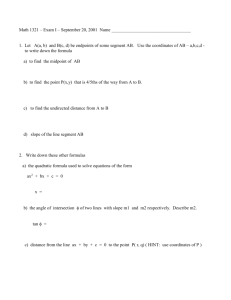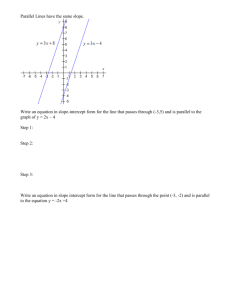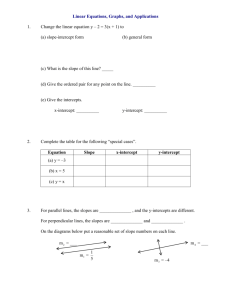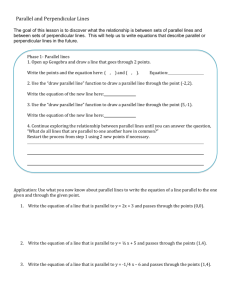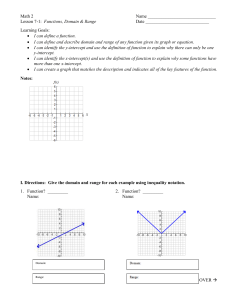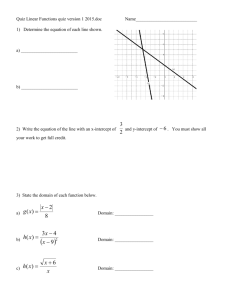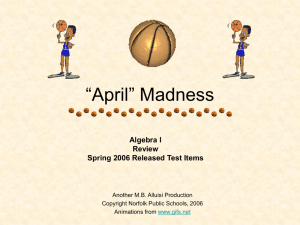S.5 CH.3 Coordinate Geometry -
advertisement
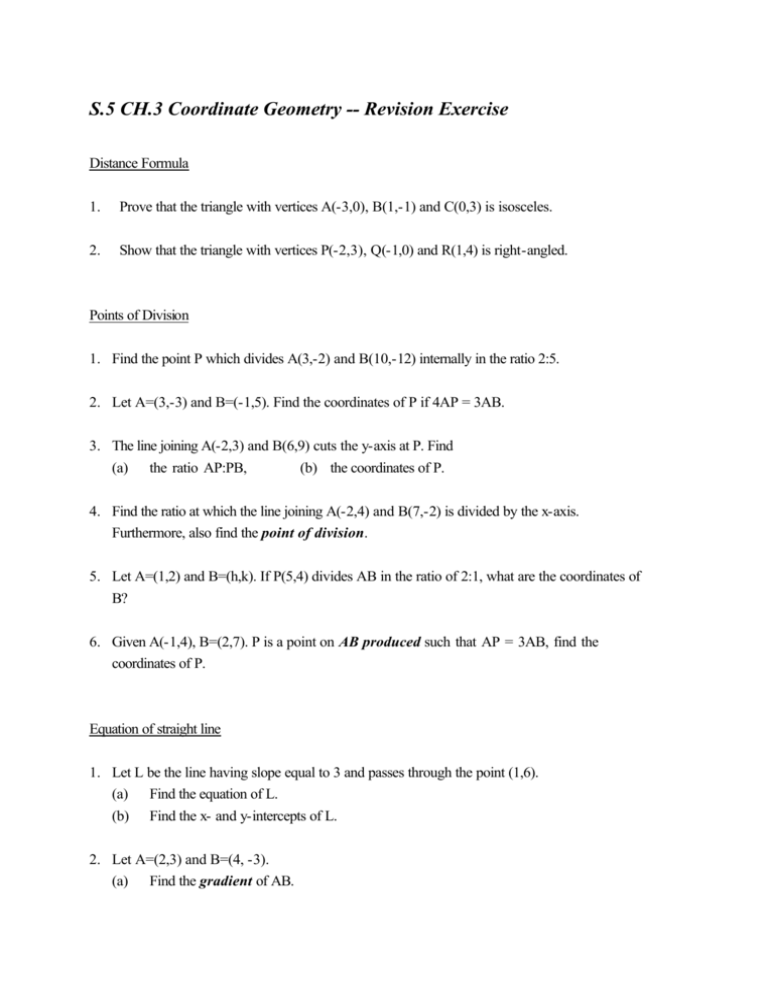
S.5 CH.3 Coordinate Geometry -- Revision Exercise Distance Formula 1. Prove that the triangle with vertices A(-3,0), B(1,-1) and C(0,3) is isosceles. 2. Show that the triangle with vertices P(-2,3), Q(-1,0) and R(1,4) is right-angled. Points of Division 1. Find the point P which divides A(3,-2) and B(10,-12) internally in the ratio 2:5. 2. Let A=(3,-3) and B=(-1,5). Find the coordinates of P if 4AP = 3AB. 3. The line joining A(-2,3) and B(6,9) cuts the y-axis at P. Find (a) the ratio AP:PB, (b) the coordinates of P. 4. Find the ratio at which the line joining A(-2,4) and B(7,-2) is divided by the x-axis. Furthermore, also find the point of division. 5. Let A=(1,2) and B=(h,k). If P(5,4) divides AB in the ratio of 2:1, what are the coordinates of B? 6. Given A(-1,4), B=(2,7). P is a point on AB produced such that AP = 3AB, find the coordinates of P. Equation of straight line 1. Let L be the line having slope equal to 3 and passes through the point (1,6). (a) Find the equation of L. (b) Find the x- and y-intercepts of L. 2. Let A=(2,3) and B=(4, -3). (a) Find the gradient of AB. (b) L is a line parallel to AB and passes through (2,-2), find the equation of L. y L1 A(3,7) -3 x O L2 3. In the figure, L1 is the line passing through A(3,7) and has x-intercept -3. L2 is a line perpendicular to L1 at A. (a) Find the slope of L1. (b) Find the slope of L2. (b) Hence find the equation of L2. 4. L is a line with slope -2 and passes through point P(-1, -2). (a) Find the equation of L. (b) Find the x-intercept and y-intercept of L. (c) Hence, find the area of triangle formed by L and the coordinate axes. 5. Both L1 and L2 pass through P(-4,2), but have slopes equal to 2 and 3 respectively. (a) Find the equations of L1 and L2. (b) L1, L2 cut the y-axis at A, B respectively. Find the coordinates of A and B. (c) Hence, find the area of the triangle PAB. 6. Given A = (-3,1) and B(5, -3). Line L passes through the mid-point M of AB and is perpendicular to AB. (a) Find the coordinates of M. (b) Find the slope of line L. (c) Hence find the equation of line L. [Note: L is called the perpendicular bisector of AB.] 7. L is a straight line passing through P(-2,5) and Q(1,2). (a) Find the equation of L. (b) Find the area of triangle enclosed by L and the coordinate axes. 8. L1 is the line y = 2x - 5. L2 is the line x - y = 3. L3 is a line passes through (-2,1). (a) Find the intersection of L1 and L2. (b) If L3 is concurrent with L1 and L2, find the equation of L3. (c) Does L3 pass through origin? Give reason. 9. Find the equation of the straight line whose x- and y-intercepts are -2 and 3 respectively. 11. P(1,3), Q(6,7), R(8,11) and S(3,7) are the vertices of a quadrilateral (i.e. a 4-sided polygon). (a) Find the equation of the line joining P to the midpoint M of QR. (b) Find the equation of the line joining Q to the midpoint N of RS. (c) Find the intersection of the two lines in (a) and (b). 12. Let L be the line 2x - 5y = 30. (a) Find the intercepts of L. (b) Hence find the area of triangle enclosed by L and the coordinate axes. 13. Given two lines L1: (2x - y) + k(x + y + 3) = 0 and L2: 4x + 2y - 11 = 0. (a) Express the slope of L1 in terms of k. (b) If L1 // L2, find the value of k. 14. (a) Find the equation of a line L which passes through the point (2,3) and is perpendicular to the line 3x - 4y + 2 = 0. (b) If the point (4, k+3) lies on L, find the value of k. 15. Given L1: kx + 2y + 3 = 0 and L2: (k-1)x - 6y - 1 = 0. Find (a) the slopes of L1 and L2 in terms of k. (b) (i) the value of k if L1 is parallel to L2 (ii) the value of k if L1 is perpendicular to L2. ANSWER Distance Formula No answer! Point of Division 1. (5, -34/7) 2. (0,3) 3. (a) 1 : 3 (b) (0,9/2) 4. 2 : 1, (4,0) 5. (7,5) 6. (8,13) Equation of Straight Line 1. (a) 3x − y + 3 = 0 (b) x-intercept = −1, y-intercept = 3 2. (a) −3 (b) 3x + y − 4 = 0 3. (a) 7/6 (b) −6/7 (c) 6x + 7y − 67 = 0 4. (a) 2x + y + 4 = 0 (b) x-intercept = − 2, y-intercept = −4 (c) 4 5. (a) L1: 2x − y + 10 = 0, L2: 3x − y + 14 = 0 (b) A(0,10), B(0,14) (c) 8 6. (a) (1,−1) (b) 2 (c) 2x + y − 3 = 0 7. (a) x + y − 3 = 0 (b) 9/2 8. (a) (2,−1) (b) x + 2y = 0 (c) Yes. Because 0 + 2(0) = 0. 9. 3x − 2y − 6 = 0 10. (a) x − y + 2 = 0 (b) 4x + y − 31 = 0 (c) (29/5, 39/5) 11. (a) x-intercept = 15, y-intercept = − 6 (b) 45 12. (a) −(k+1)/(k+2) (b) −3 13. (a) 4x + 3y − 17 = 0 (b) −8/3 14. (a) L1: −k/2, L2: (k−1)/6 (b) (i) 1/4 (ii) 4 or −3

